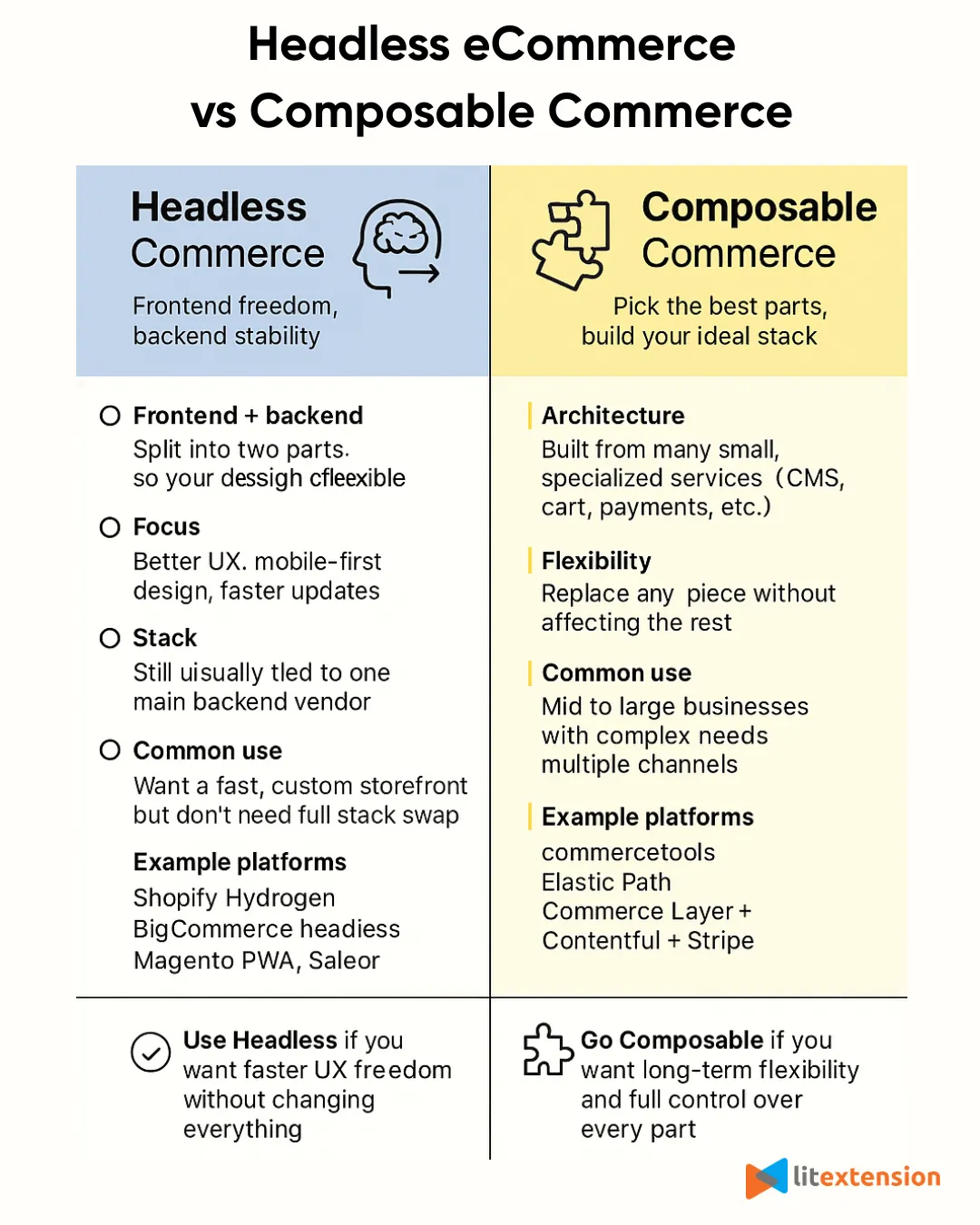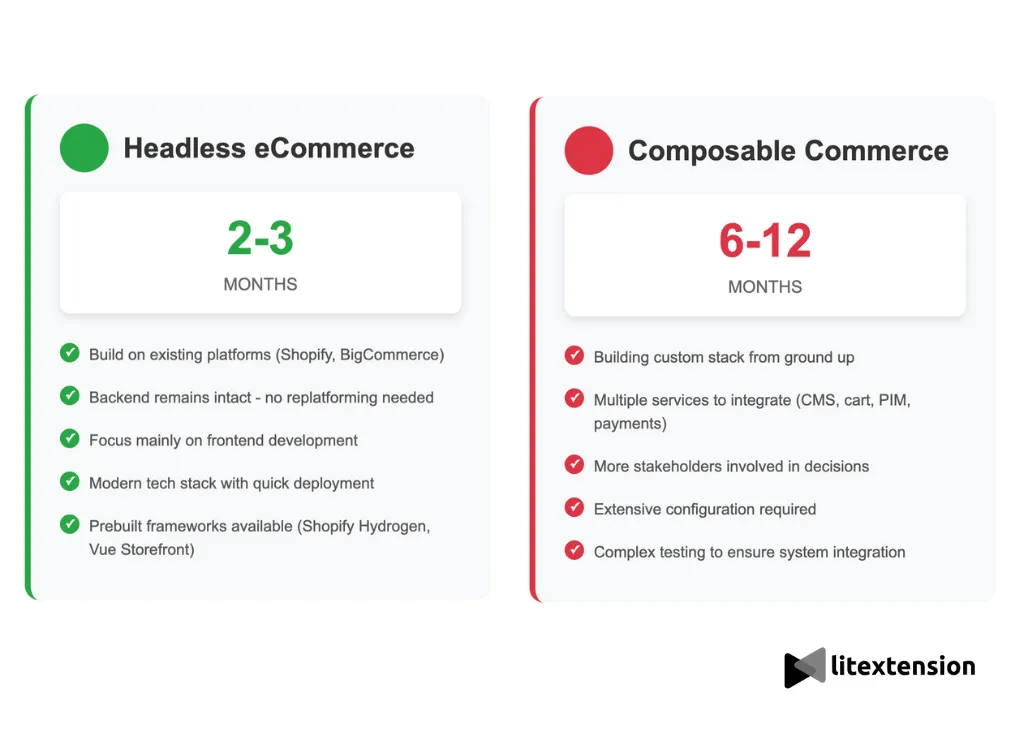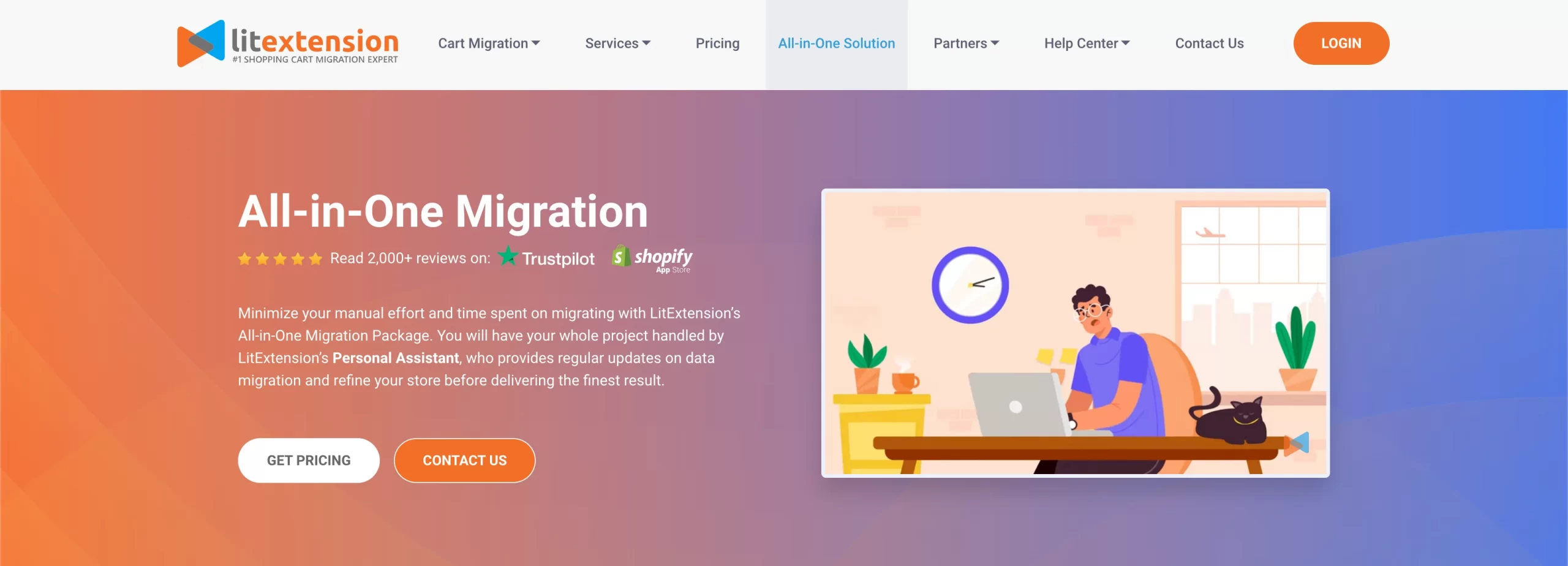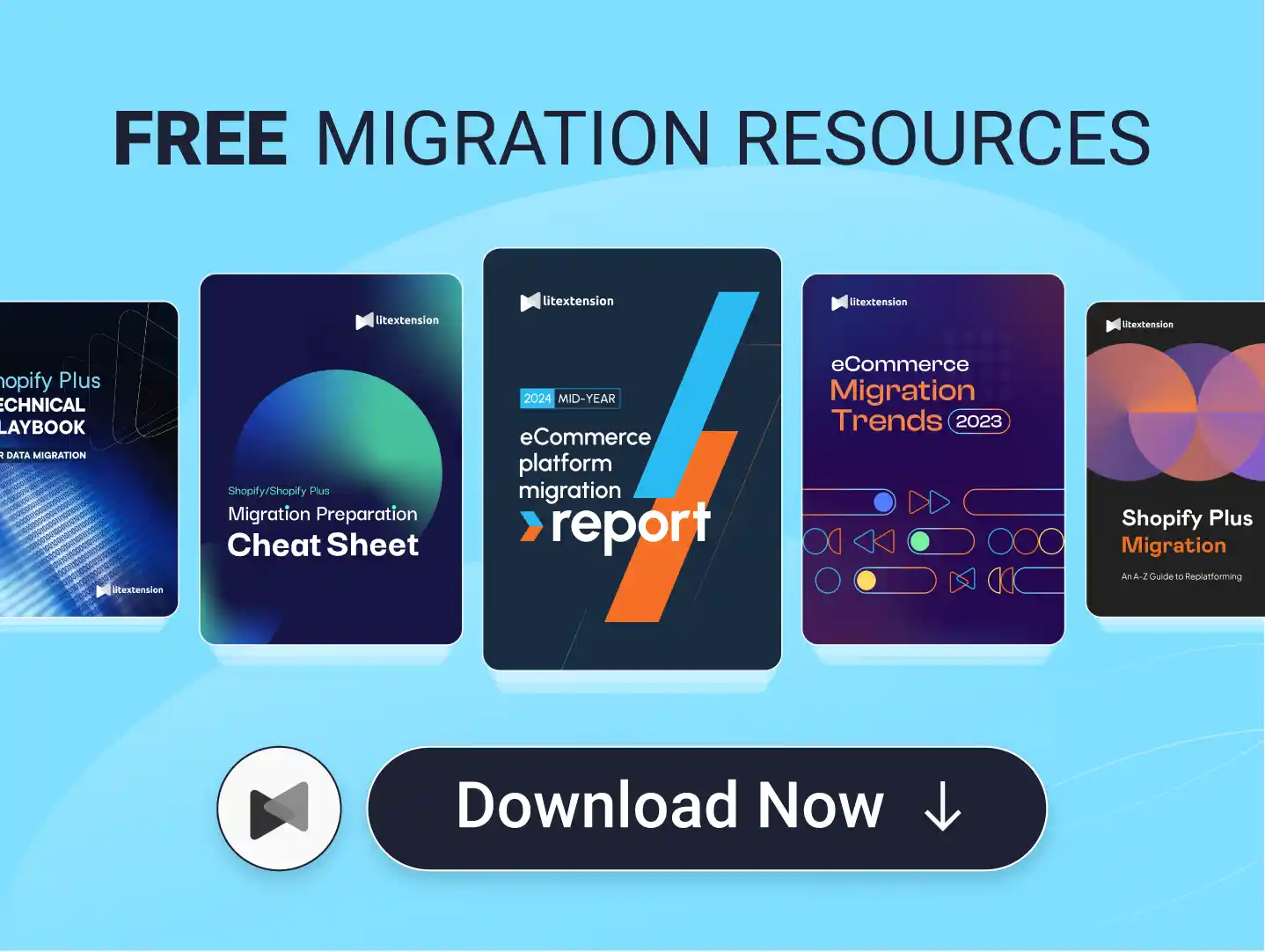As eCommerce grows more complex and customer expectations rise, businesses are rethinking the architecture behind their online stores. Two of the most widely discussed approaches—composable commerce vs headless eCommerce—promise flexibility, speed, and scalability.
But what exactly do they mean? And more importantly, which one fits your business needs?
If you’re an eCommerce manager, CTO, or digital product owner in the middle of a replatforming or architectural decision, this guide is for you. We’ll go beyond basic definitions to offer:
- A side-by-side comparison of headless vs composable commerce
- Practical advice on when to choose one over the other
- MACH vs composable vs headless: where MACH fits in?
Let’s break it all down!
Why Commerce Architecture Is Changing
The way consumers shop and the technologies that support them have evolved rapidly. In response, businesses are rethinking their underlying eCommerce architecture. What once worked for a single-channel, desktop-focused shopping experience now struggles to keep up with modern demands for speed, flexibility, and seamless integration across systems.
From monolithic to modular: What’s the problem?
Traditional monolithic platforms (like Magento, WooCommerce, or legacy custom builds) were designed to be all-in-one systems—frontend, backend, CMS, checkout, and data all bundled together. While simple at first, these platforms now create friction as businesses grow.
For fast-moving brands, these constraints translate into missed opportunities.
Then comes the rise of API-first and modular commerce models!
Modern commerce architecture is moving toward API-first, modular, and service-based models. These architectures decouple components, letting businesses choose best-in-class services for each function (e.g., Algolia for search, Contentful for content, Stripe for payments).
You may see many benefits of modular/API-first design:
- Flexibility to swap or upgrade individual services
- Frontend freedom across devices and channels
- Faster deployment of features or experiences
- Easier integration with existing systems (ERP, CRM, OMS…
This evolution sets the stage for headless commerce and its more advanced counterpart: composable commerce.
In short, modern commerce demands modern architecture—and that’s why headless and composable approaches are rising fast.
Quick Context: Headless eCommerce vs Composable Commerce in Plain Terms
Let’s strip away the buzzwords for a second.
What is headless eCommerce?
Headless commerce is really just a modern way of saying “API-first.” Your frontend (what customers see) and your backend (where the logic and data live) are separated, and they talk to each other via APIs. Most often, the frontend is a JavaScript app (like React or Vue), but it could also be a mobile app, a kiosk, or even a voice assistant.
This setup isn’t actually new. Developers have been decoupling systems since the early days of AJAX in the late ’90s. Back then, it was more expensive than traditional websites, but now, with businesses needing to serve multiple channels (like web, mobile, in-store, and even voice), having one backend serve many frontends has become more efficient, not less.
So why all the hype now? Because eCommerce is finally catching up to this model — and “headless” just became the catchy label that stuck.
Here are some examples of headless eCommerce platforms: Shopify Hydrogen and Storefront API, BigCommerce headless, Magento 2 with PWA Studio, Saleor, Vue Storefront, etc.
Learn more: 10+ Best headless eCommerce platforms for modern brands
What is composable commerce?
While headless is about how things are connected, composable is more about what you're connecting, and why.
With composable commerce, you don’t rely on one platform to do everything. Instead, you select the best tools for each job — maybe Contentful for CMS, Algolia for search, Stripe for payments — and build a solution that fits your business, not someone else’s template.
Composable commerce was formalized by Gartner and focuses less on tech stack choices and more on long-term adaptability. Platforms like commercetools, Elastic Path, and Commerce Layer support this model through productized integrations and API-based orchestration.
TL;DR:
- Headless = You separate the storefront from the backend, allowing you to control the user experience without modifying the underlying components.
- Composable = You assemble a full commerce stack from specialized services, giving you flexibility at every layer, not just the frontend.
They're connected, but not the same, and understanding the difference helps you plan not just for launch, but for scale.
Composable Commerce vs Headless eCommerce: A Side-by-Side Comparison
Not sure which approach is the better fit? Here’s a direct, side-by-side breakdown of composable and headless commerce across the areas that matter most — from cost and flexibility to scalability and ease of maintenance.
You can use this table as a quick reference when deciding which architecture supports your goals now and in the future.
Category | Headless Commerce | Composable Commerce | Winner |
Total cost of ownership | Lower upfront and ongoing cost; predictable SaaS pricing | Higher initial investment; multiple services and vendors add up | Headless |
Architecture scope | Decouples frontend only; backend remains platform-managed | Full-stack modularity; each service is independent | Composable |
Flexibility & customization | Flexible UI/UX; limited backend customization | Full customization across frontend and backend | Composable |
Scalability | Scales frontend well; backend scale limited by platform | Scales independently across services and business models | Composable |
Integration strategy | API-ready; integration options depend on core platform | Built for integration; plug-and-play with best-of-breed tools | Composable |
Development complexity | Moderate; manageable for small to mid-sized dev teams | High; requires strong dev resources or external partners | Headless |
Vendor lock-in & portability | Tied to core platform for backend operations | Minimal lock-in; each service can be replaced as needed | Composable |
Maintenance & support | Platform handles backend updates; frontend requires some upkeep | All components require monitoring and maintenance; more responsibility overall | Headless |
Time to market | Faster launch (2–3 months typical); uses existing backend | Longer build time (6–12 months); more planning and integration needed | Headless |
*Note: If you're forced to choose one, Composable Commerce wins for long-term flexibility and scale. But for many mid-market businesses, Headless is the smarter near-term choice.
1. Total cost of ownership
Let’s talk real numbers between composable commerce vs headless eCommerce. One of the biggest questions when choosing between headless vs composable commerce is: How much is this going to cost me, not just now, but long-term?
Category | Headless commerce | Composable commerce |
Platform costs | $1K–$5K/month (Shopify Plus, BigCommerce) | $100K–$500K+/year (commercetools, Elastic Path) |
Build costs | $15K–$50K (custom frontend only) | $100K–$500K+ (full stack: cart, PIM, CMS, etc.) |
3rd-party tools | $100–$1K/month (CMS, search, analytics) | $3K–$10K+/month (CMS, PIM, CDN, orchestration) |
Maintenance | $500–$2K/month | $5K–$20K+/month |
Time to market | 2–3 months | 6–12 months |
Team requirements | Frontend developers, moderate API knowledge | Full-stack dev team or agency + API orchestration |
If you’re using a platform like Shopify Plus or BigCommerce, going headless means keeping your backend and swapping out the frontend for something custom, like a React or Vue storefront.
Composable commerce is like building your own tech stack from the ground up. You choose the best tools for each part of the store — PIM, CMS, cart, search, payments — and stitch them together with APIs. But that freedom comes with higher costs.
Verdict: Headless Commerce wins on cost
If you're looking for a balance of customization and affordability, headless commerce delivers more value for most mid-sized brands.
2. Architecture scope
Architecture scope is all about how much of your eCommerce stack you’re breaking apart and rebuilding. Here comes the simple terms for headless composable architecture: headless changes the frontend, while composable changes everything.

Headless commerce decouples the frontend (your storefront) from the backend (product catalog, checkout, order processing). You still rely on your main platform — like Shopify or BigCommerce — to manage core business logic, but you’re free to build any kind of user interface on top. It’s a big improvement over traditional setups, but it has limits. You’re customizing the surface, not the foundation.

Composable architecture goes beyond the frontend. It breaks your entire commerce stack into independent components, allowing you to assemble the perfect mix for your business. You don’t just swap out the storefront — you also choose the PIM, CMS, cart, promotions engine, search, checkout, and even loyalty tools from best-in-class providers.
Verdict: Composable Commerce wins
If you want full control, not just over how your store looks, but how it works, composable commerce gives you the architectural freedom that headless can’t match. Headless is a great first step, but composable is the finish line.
3. Level of flexibility & customization
This one’s simple: how much can you change, and how much is locked in?
Headless commerce gives you control over the presentation layer. You can build any storefront you like using modern frameworks, optimize for performance, and tailor the customer experience. But the backend is still bound to the limitations of your core platform.
You can only customize what your platform allows, and deeper changes (such as custom checkout flows or pricing rules) may require workarounds rather than real control.
Composable commerce lets you shape not just how your store looks, but how it works behind the scenes. From the way products are structured in your PIM, to how promotions are triggered, to how payments or fulfillment is handled, every component is modular and replaceable.
This level of flexibility supports more complex business models (multi-brand, B2B, subscription) and allows you to grow without architectural bottlenecks.
Verdict: Composable Commerce wins
While headless gives you more freedom than traditional platforms, it stops at the frontend. Composable commerce offers flexibility across the entire stack, making it the stronger choice for businesses that require customization at both the user interface (UI) and operational levels.
4. Scalability
As your business grows — more products, more traffic, more regions, more channels — your architecture needs to keep up.
Headless setups are generally faster and more flexible than monolithic systems. You can build lightweight, high-performing storefronts, connect to different frontends (like mobile apps or kiosks), and serve content across channels.
But your backend still carries the weight. Scaling product data, order volume, or multi-store operations depends on what your core platform can handle. If the backend wasn’t designed for large-scale operations, you may eventually hit limitations.
Composable architecture is modular by nature, which makes it much easier to scale across business models, geographies, and traffic spikes. You can independently scale services — like adding a new CMS for a regional site, or connecting a second PIM to manage multiple catalogs.
Each component can be optimized or upgraded without disrupting the whole system. That kind of decoupling matters when you’re managing growth in multiple directions.
Verdict: Composable Commerce wins
If you’re planning to expand — more regions, brands, or complexity — composable commerce gives you a clear path to scale without outgrowing your stack. Headless is a step forward, but composable is built for longevity.
5. Integration strategy
Modern eCommerce rarely runs on a single platform. Most businesses rely on a growing mix of systems — ERP, CRM, CMS, PIM, marketing tools, and more. How your architecture, composable commerce vs headless eCommerce, handles those connections can make or break your operations.
Headless platforms support integrations through APIs, which is a major step up from older, closed systems. You can connect to third-party tools like a CMS or analytics platform, and most modern SaaS platforms offer built-in apps or connectors to speed things up.
But here's the catch: you’re still operating within the boundaries of your main platform. Custom integrations beyond what’s supported might require workarounds or custom apps — and managing complex workflows across systems isn’t always seamless.
Composable commerce is built to integrate. Every component is designed to communicate via APIs — whether it’s a CMS like Contentful, a PIM like Akeneo, or a personalization engine. You’re not just plugging tools into a single platform — you’re orchestrating a network of best-in-class services.
This setup gives you more freedom to choose the tools that actually fit your business — not just the ones your platform supports. It also allows for deeper, more efficient integration across your ecosystem.
Verdict: Composable Commerce wins
If integration is central to your business — whether you’re managing complex data flows or using multiple specialized systems — composable commerce offers more flexibility and cleaner, future-ready connectivity.
6. Development complexity
More flexibility often means more responsibility, especially for your dev team. So let’s look at how much technical effort it takes to build, launch, and maintain each approach, composable commerce vs headless eCommerce.
Going headless usually means building a custom frontend while keeping the existing backend intact. You’ll need developers familiar with modern frontend frameworks (like React or Vue), and some knowledge of APIs to connect it all.
The learning curve is there, but it’s manageable — especially if you're working with a platform like Shopify or BigCommerce, which already provides APIs and documentation. For mid-sized teams or agencies, this is often a realistic path that balances control and complexity.
Composable gives you full-stack control, but with that comes architectural complexity. You're not just building a custom frontend, you're also integrating and maintaining multiple services (CMS, PIM, cart, search, checkout, payments…).
This requires a skilled development team (or partner) that can manage microservices, handle orchestration between APIs, and ensure performance and data consistency across systems. Without strong technical oversight, this can become overwhelming fast.
Verdict: Headless Commerce wins
Headless commerce offers a powerful middle ground — you get flexibility on the frontend without the heavy engineering lift of managing a fully modular stack. It’s the better option for businesses that want customization but need to keep development manageable.
7. Vendor lock-in & portability
One of the biggest long-term risks in eCommerce architecture is getting locked into a single platform, where switching or upgrading becomes painful, expensive, or nearly impossible. Let’s see how headless and composable compare here.
Even though headless separates the frontend from the backend, you’re still relying on a single platform to manage critical business functions, like checkout, order management, and product data. That means:
- If your backend platform has limitations, you’re stuck working around them.
- Migrating away later could be just as complex as moving off a traditional monolith.
- Your flexibility is mostly on the customer-facing side, not the operational core.
So while you’ve gained some freedom, your architecture is still heavily shaped by your vendor.
Composable commerce is built to avoid lock-in. Each part of your system is modular and replaceable, which means:
- You can swap out your CMS or search engine without affecting the rest of your stack.
- You can avoid relying too heavily on a single vendor's roadmap or limitations.
- You own the orchestration and architecture, not the platform provider.
This not only improves flexibility but also gives your business more leverage over time.
Verdict: Composable Commerce wins
When it comes to avoiding vendor lock-in and keeping your options open long-term, composable commerce is the clear winner. You’re not building on someone else’s limits — you’re building a stack you can evolve as your business grows.
8. Maintenance & support
Flexibility is great, but someone still has to keep the system running. Let’s look at what ongoing maintenance and support looks like for both approaches — and how much of the load falls on your team.
With headless, you're still relying on a centralized platform (like Shopify or BigCommerce) to handle critical backend updates, hosting, security, and scaling. That’s a big relief for most teams. Your responsibility mainly lies in:
- Maintaining your custom frontend
- Managing integrations with CMS or third-party tools
- Handling bug fixes or UX improvements
And if something breaks on the backend? You have platform support to lean on. Overall, this model strikes a balance — you get freedom where it counts, without taking on the full burden of system operations.
Composable commerce means you’re assembling a stack of independent services — which also means you (or your team) are responsible for keeping all the moving parts running smoothly.
Ongoing maintenance often includes:
- Monitoring multiple APIs and services
- Managing upgrades across systems
- Troubleshooting complex cross-service bugs
- Ensuring performance and uptime across your stack
You’ll either need a strong in-house dev team or a trusted systems integrator — and the costs and effort can add up quickly.
Verdict: Headless Commerce wins
For most businesses, especially those without a dedicated engineering team, headless is easier to maintain and comes with stronger vendor support. Composable gives you more freedom, but also more operational weight to carry.
9. Time to market
If speed is critical — whether you're launching a new storefront, entering a new region, or just trying to outpace competitors — your architecture choice, composable commerce vs headless eCommerce, can make a big difference.
Headless setups typically build on top of existing platforms, like Shopify or BigCommerce. Since the backend remains intact, most of your effort goes into designing and developing the frontend. That means:
- You avoid replatforming the backend
- You can move quickly with a modern tech stack
- You get the benefit of frontend flexibility without a long dev cycle
For most teams, a headless project can be launched in 2–3 months, especially with a good development partner or prebuilt framework (like Shopify Hydrogen or Vue Storefront).
Composable commerce requires more upfront planning. You’re not just launching a storefront — you’re building and connecting a custom stack (CMS, cart, PIM, payments, etc.). This added complexity means:
- More stakeholders
- More configuration
- More testing to ensure systems talk to each other properly
Most composable builds take 6–12 months, depending on the level of complexity and the number of services involved.
Verdict: Headless Commerce wins
If time-to-market matters — and it usually does — headless gets you there faster. Composable solutions pay off in flexibility and scale, but they take longer to get up and running.
When to Choose Headless or Composable Commerce?
If you’ve made it this far, you’re likely thinking: Which one fits my business better? This section provides you with clear guidance based on your current stage in the growth journey, the way your team operates, and your technical priorities.
You’re a growing brand needing more UX control (go headless)
If your current platform feels like a design cage, limiting your ability to create a fast and modern storefront, but you’re not ready to rebuild your backend, a headless approach is a smart move.
You keep what’s working on the backend (like Shopify or BigCommerce) but design the frontend exactly how you want it. It’s ideal if your focus is on customer experience, site performance, or building brand differentiation, without blowing up your stack.
Best for:
- Mid-sized D2C brands
- Teams focused on UX improvements
- Stores already running on a modern SaaS backend
For example, Canadian apparel brand Kotn moved to a headless Shopify setup to gain design freedom and improve site performance. They kept Shopify’s backend for product and order management while building a custom frontend that reflects their minimalist, values-driven brand.
You have an advanced tech team or system integrator (go composable)
If you’ve got a skilled in-house engineering team or a strong development partner, and you're comfortable managing a more complex stack, composable commerce unlocks the highest level of flexibility.
This is especially valuable for businesses that operate across regions, brands, or channels and need a tailored, scalable solution.
Best for:
- Enterprise retailers
- Multi-brand or multi-region operations
- Teams that want full control over backend and frontend
You need to launch fast and customize later (go headless)
Not every project needs a long planning cycle. If your priority is speed — getting to market quickly, testing a new product line, or rebuilding your storefront on a tighter timeline — headless is easier to execute.
You’ll still gain flexibility, but with fewer moving parts and shorter launch windows.
Best for:
- Time-sensitive replatforming
- MVP storefront launches
- Agile teams running A/B tests or frontend experiments
You rely on complex tools and deep integrations (go composable)
If your business already uses — or plans to use — a network of systems (PIMs, ERPs, CRMs, headless CMSs, etc.), composable commerce is a better architectural fit.
It’s designed for ecosystems, not silos. You’ll have the freedom to build exactly what you need, and the ability to scale it without being constrained.
Best for:
- B2B or hybrid B2B/B2C companies
- Retailers with multi-system dependencies
- Stores with heavy automation and data orchestration needs
Seamlessly migrate your store to a more robust place!
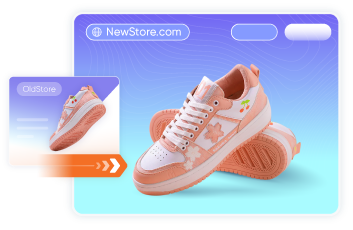
Migration Considerations: Moving to Headless or Composable
Switching to a modern commerce architecture — whether headless or composable — isn’t just about picking the right tools. It’s also about moving your existing data and systems over safely, without losing SEO, order history, or customer trust.
Migrating from monolithic platforms
If you're currently on a traditional all-in-one platform (like Magento, WooCommerce, or PrestaShop), chances are your data and structure are tightly coupled. Moving to a headless or composable setup usually means:
- Restructuring your product catalog
- Rethinking how content, media, and checkout are managed
- Mapping customer and order data into new formats
This can be complex, especially when combining multiple systems (e.g., migrating to Shopify, Contentful, Algolia, and Stripe).
API and data migration challenges
Headless and composable stacks are API-first, which means your data must be clean, consistent, and structured in a way that allows other services to consume it. Common challenges include:
- Product variants and attributes don’t map 1:1 between systems
- Custom fields or meta data may not carry over cleanly
- SEO-critical URLs, redirects, and media need special handling
- Maintaining order history and customer accounts without data loss
This isn’t something most teams want to handle manually — especially mid-migration.
Deciding between headless or composable
If you’re still undecided, let’s consider this:
- Choose headless if you want a smoother, faster migration by keeping your current platform as the backend.
- Choose composable if you're ready for a deeper rearchitecture and need full-stack flexibility for long-term scalability.
Start by defining your key goals: Is your priority speed? Flexibility? Control? Multi-channel growth? Your answer will guide your path.
No matter which direction you’re going, LitExtension simplifies the migration process — from monolithic platforms to headless or composable stacks.
We handle:
- Products, customers, orders, reviews, and more
- 301 redirects and post-migration SEO
- Support for platforms like Shopify, BigCommerce, commercetools, Magento, WooCommerce, and others
- Post-launch syncing and error checking
Ready to modernize? Let us take care of the data, so you can focus on the future.
MACH vs Composable vs Headless: Where MACH Fits in?
You’ve probably seen the term MACH pop up alongside headless and composable commerce. While they’re related, they’re not the same, and it’s important to understand how MACH fits into the picture if you're evaluating your long-term architecture strategy.
MACH stands for:
- Microservices — modular services, not monoliths
- API-first — systems talk to each other through APIs
- Cloud-native — built for performance and scalability
- Headless — frontend and backend are decoupled
It’s not a product or platform, it’s an architectural mindset. MACH was coined by the MACH Alliance and is designed to promote flexibility, scalability, and future-readiness. Each part of the acronym represents a principle for building modular, composable systems.
So, how MACH relates to headless and composable?
You can think of MACH as the technical foundation, while headless and composable are applications of that foundation:
- Headless commerce focuses on the frontend/backend separation – a subset of MACH.
- Composable commerce builds on MACH principles by applying them across the entire stack – CMS, PIM, payments, cart, etc.
So, while headless may use MACH ideas (like API-first), composable embraces MACH fully by treating every part of your system as a replaceable service.
But not every brand needs to pursue MACH certification. Let’s choose a MACH-aligned or certified platform if:
- You’re an enterprise planning a long-term digital transformation
- You want to avoid vendor lock-in and build a future-proof stack
- You rely on multiple systems and want to manage them through well-defined APIs
- You’re investing in global, omnichannel, or multi-brand operations
Platforms like commercetools, Contentstack, Algolia, and Commerce Layer are strong examples of MACH-based vendors.
If composable commerce is your destination, MACH is the road that gets you there, built for brands that value agility, modularity, and long-term ownership of their tech stack.
Composable Commerce vs Headless eCommerce: FAQs
What does composable commerce mean?
Composable commerce is an approach where businesses assemble their tech stack using best-of-breed services for each function — like CMS, cart, payments, PIM, and search. These tools are integrated via APIs, allowing for a fully tailored and scalable eCommerce system.
What does headless eCommerce mean?
Headless eCommerce means your storefront (the “head”) is separated from the backend system. The frontend communicates with the backend using APIs. This setup allows businesses to design custom experiences while still using a robust commerce engine behind the scenes. It’s called “headless” because the frontend is no longer fixed, you can build it any way you want.
What is the difference between headless and composable commerce?
Headless commerce decouples the frontend (what users see) from the backend (where business logic lives), allowing for greater design flexibility. Composable commerce takes it further by breaking down every part of the commerce stack into modular, API-connected components, not just the frontend.
What is the difference between headless commerce and traditional commerce?
Traditional commerce platforms are monolithic, the frontend and backend are tightly connected, which can make customization difficult. Headless commerce separates the two, giving teams more control over the customer experience while still using the existing backend for core commerce operations. This separation makes it easier to innovate, experiment, and scale across channels (like mobile, web, or POS).
Is headless eCommerce a future-proof solution?
Yes, for many growing brands, headless eCommerce offers a solid, future-ready path — especially if you want more control over your storefront without rebuilding your backend. However, if your business will eventually require full-stack flexibility or deep system orchestration, composable commerce may be a more scalable long-term fit.
Is composable commerce the same as MACH architecture?
Not exactly. MACH is a set of technical principles — Microservices, API-first, Cloud-native, and Headless — that composable commerce is often built on. Composable is a broader approach focused on assembling a best-of-breed stack for business needs, while MACH is more of a technical certification or framework behind it.
Final Words: So, Headless or Composable? Let’s Make It Simple!
If you’re a growing brand that wants more frontend control without overcomplicating your stack, headless is a practical, cost-effective next step. But if you’re planning for scale, complexity, or long-term flexibility, composable commerce gives you the control and adaptability that modern businesses need.
There’s no one-size-fits-all answer, but there is a right fit for where you are today and where you're headed next.
At LitExtension, we specialize in helping businesses migrate to modern, API-first platforms with complete data accuracy and minimal downtime. From Shopify Hydrogen to commercetools composable or a custom stack of your choice, our migration experts ensure your products, orders, and customers are fully preserved and future-ready.
We hope you found this article insightful and now have a clear understanding of composable commerce vs headless eCommerce. For more content like this, be sure to visit the LitExtension blog and join our eCommerce community to gain further insights and connect with fellow business owners.
